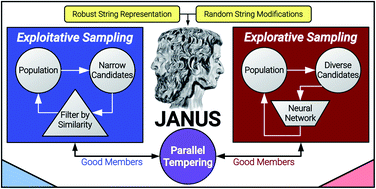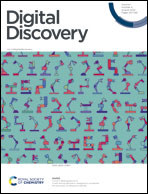Parallel tempered genetic algorithm guided by deep neural networks for inverse molecular design†
Abstract
Inverse molecular design involves algorithms that sample molecules with specific target properties from a multitude of candidates and can be posed as an optimization problem. High-dimensional optimization tasks in the natural sciences are commonly tackled via population-based metaheuristic optimization algorithms such as evolutionary algorithms. However, often unavoidable expensive property evaluation can limit the widespread use of such approaches as the associated cost can become prohibitive. Herein, we present JANUS, a genetic algorithm inspired by parallel tempering. It propagates two populations, one for exploration and another for exploitation, improving optimization by reducing property evaluations. JANUS is augmented by a deep neural network that approximates molecular properties and relies on active learning for enhanced molecular sampling. It uses the SELFIES representation and the STONED algorithm for the efficient generation of structures, and outperforms other generative models in common inverse molecular design tasks achieving state-of-the-art target metrics across multiple benchmarks. As neither most of the benchmarks nor the structure generator in JANUS account for synthesizability, a significant fraction of the proposed molecules is synthetically infeasible demonstrating that this aspect needs to be considered when evaluating the performance of molecular generative models.



 Please wait while we load your content...
Please wait while we load your content...